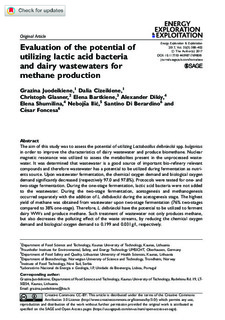| dc.contributor.author | Juodeikiene, Grazina | |
| dc.contributor.author | Cizeikiene, Dalia | |
| dc.contributor.author | Glasner, Christoph | |
| dc.contributor.author | Bartkiene, Elena | |
| dc.contributor.author | Dikiy, Alexander | |
| dc.contributor.author | Shumilina, Elena | |
| dc.contributor.author | Ilic, Nebojsa | |
| dc.contributor.author | Di Berardino, Santino | |
| dc.contributor.author | Foncesa, Cesar | |
| dc.date.accessioned | 2018-04-13T08:31:11Z | |
| dc.date.available | 2018-04-13T08:31:11Z | |
| dc.date.created | 2017-10-19T12:22:31Z | |
| dc.date.issued | 2017 | |
| dc.identifier.citation | Energy exploration & exploitation. 2017, 35 (3), 388-402. | nb_NO |
| dc.identifier.issn | 0144-5987 | |
| dc.identifier.uri | http://hdl.handle.net/11250/2494009 | |
| dc.description.abstract | The aim of this study was to assess the potential of utilizing Lactobacillus delbru¨eckii spp. bulgaricus in order to improve the characteristics of dairy wastewater and produce biomethane. Nuclear magnetic resonance was utilized to assess the metabolites present in the unprocessed wastewater. It was determined that wastewater is a good source of important bio-refinery relevant compounds and therefore wastewater has a potential to be utilized during fermentation as nutrients source. Upon wastewater fermentation, the chemical oxygen demand and biological oxygen demand significantly decreased (respectively 97.0 and 97.8%). Protocols were tested for one- and two-stage fermentation. During the one-stage fermentation, lactic acid bacteria were not added to the wastewater. During the two-stage fermentation, acetogenesis and methanogenesis occurred separately with the addition of L. delbdueckii during the acetogenesis stage. The highest yield of methane was obtained from wastewater upon two-stage fermentation (76% two-stages compared to 38% one-stage). Therefore, L. delbru¨eckii have the potential to be utilized to ferment dairy WWs and produce methane. Such treatment of wastewater not only produces methane, but also decreases the polluting effect of the waste streams, by reducing the chemical oxygen demand and biological oxygen demand to 0.199 and 0.031 g/l, respectively. | nb_NO |
| dc.language.iso | eng | nb_NO |
| dc.publisher | SAGE Publications | nb_NO |
| dc.rights | Navngivelse 4.0 Internasjonal | * |
| dc.rights.uri | http://creativecommons.org/licenses/by/4.0/deed.no | * |
| dc.title | Evaluation of the potential of utilizing lactic acid bacteria and dairy wastewaters for methane production | nb_NO |
| dc.type | Journal article | nb_NO |
| dc.type | Peer reviewed | nb_NO |
| dc.description.version | publishedVersion | nb_NO |
| dc.source.pagenumber | 388-402 | nb_NO |
| dc.source.volume | 35 | nb_NO |
| dc.source.journal | Energy exploration & exploitation | nb_NO |
| dc.source.issue | 3 | nb_NO |
| dc.identifier.doi | 10.1177/0144598717698081 | |
| dc.identifier.cristin | 1505904 | |
| dc.description.localcode | (C) The Author(s) 2017. Creative Commons CC-BY: This article is distributed under the terms of the Creative Commons Attribution 3.0 License (http://www.creativecommons.org/licenses/by/3.0/) which permits any use, reproduction and distribution of the work without further permission provided the original work is attributed as specified on the SAGE and Open Access pages (https://us.sagepub.com/en-us/nam/open-access-at-sage). | nb_NO |
| cristin.unitcode | 194,66,15,0 | |
| cristin.unitname | Institutt for bioteknologi og matvitenskap | |
| cristin.ispublished | true | |
| cristin.fulltext | original | |
| cristin.qualitycode | 1 | |

